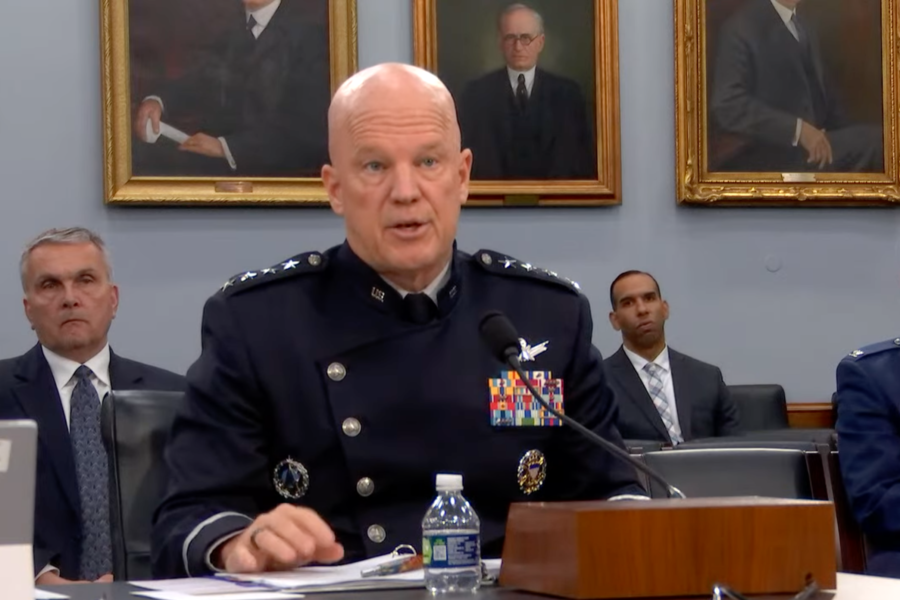The Space Force is running the risk of starting more programs than it can afford, at least according to its five-year budget plan that isn’t “credible,” according to a key congressional panel.
The House Appropriations defense subcommittee offered that stark warning as part of the report it submitted alongside its 2023 appropriations bill, which will be considered by the full committee June 22.
Looking to address those financial concerns, House appropriators included a provision in their bill that would require the Secretary of the Air Force, through the assistant secretary for space acquisition and integration, to conduct a risk assessment analysis of the “projected cost, affordability, and executability” of the entire Space Force portfolio of programs and activities and to present the results to lawmakers by Oct. 1.
The bill would also trim the Space Force budget request for military personnel; operations and maintenance; and research, development, testing, and evaluation, with the biggest difference being to the RDT&E budget—nearly $358 million less than what the service asked for.
Such changes would modestly change the overall top line of $24.5 billion in the 2023 Space Force budget request—that total was a substantial $6.5 billion increase over the $18 billion enacted by Congress for fiscal 2022. House appropriators noted that a chunk of that increase is a result of the Space Development Agency integrating into the service as well as more inter-service troop transfers. Still, even after adjusting for those changes, the committee report pegged the growth at roughly 20 percent.
Another increase is projected for fiscal 2024, according to the Pentagon’s Future Years Defense Program, which projects spending five years in advance. After that, however, the top line is projected to decrease—and lawmakers are concerned.
“The Space Force’s ambitious plans for new architectures, programs, and mission areas, do not appear to be backed up with credible budget projections in the outyears to actually deliver these capabilities,” the HAC-D committee report states.
With smaller budgets supposedly coming, the Space Force may be overextending itself, the report adds.
“The Committee cautions the Space Force against starting more programs than it can afford,” the report says. “The lack of a credible five-year budget raises fundamental questions about whether any serious analysis or long-term planning has been done to assess the realism and affordability of the entire portfolio of programs—not just individual programs—or to set priorities among programs, including deciding not to start programs if they are not affordable within projected budgets.”
The chair of the defense subcommittee, Rep. Betty McCollum (D-Minn.), questioned Air Force Secretary Frank Kendall on this topic when he appeared before lawmakers in May. Kendall indicated that he thought the FYDP would wind up changing over time, saying he did not believe future budgets “will remain flat or go down for the Space Force—quite the opposite.”
But Kendall’s answers were seemingly not enough to satisfy lawmakers’ concerns, with the report stating that the Space Force’s budget fails to meet the committee’s expectation that its “plans and programs must be based on rigorous technical analysis matched with executable plans resourced by realistic budgets.”
In particular, the committee report takes aim at the Space Force’s plans to significantly boost spending on its missile warning enterprise.
All told, the service wants more than $4.5 billion for missile warning in 2023, including billions of dollars for Next-Generation Overhead Persistent Infrared geosynchronous satellites, hundreds of millions of dollars for the Tracking Layer of SDA’s National Defense Space Architecture in low Earth orbit, and more than a billion dollars for a “Resilient Missile Warning/Missile Tracking” program.
While applauding the Space Force for trying to build a more resilient architecture spread across different orbits, the committee report warned that the service “has not provided sufficient information on the expected life-cycle cost of the new architecture, the cost to recapitalize a proliferated architecture every 3–5 years, potential risks and challenges in the supply chain, the ability of the Space Force to scale up capabilities to command and control a much larger number of satellites, the applicability and ability to meet stringent requirements for missile warning certification, cybersecurity, and resilience against reversible and irreversible kinetic and non-kinetic attacks.”
Looking to address that, the committee is asking for a life-cycle cost estimate for the proposed Resilient Missile Warning/Missile Tracking program by January 2023, as well as quarterly updates on that program and Next-Gen OPIR.


